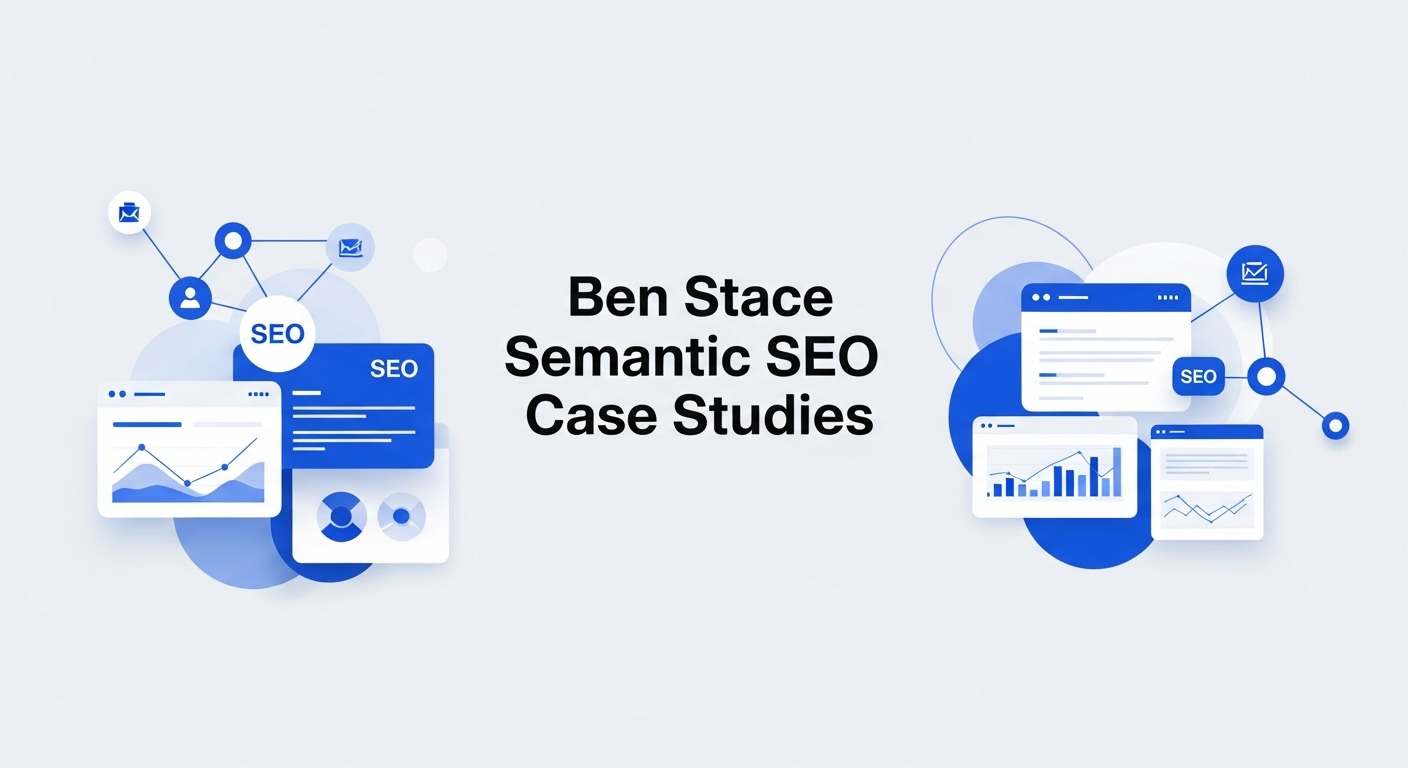Ben Stace’s semantic SEO case studies show how shifting from old-fashioned keyword tricks to a meaning-driven approach can dramatically boost rankings and traffic. In these real-world examples, clients restructured their content around topics and entities – for instance, one e-commerce site jumped into Google’s top-3 for 22 target keywords after Stace’s methods, and another health site saw a 187% surge in organic visits in just 90 days. The clear takeaway is that optimizing for context and intent (not just repeating exact phrases) is a powerful, future-proof SEO strategy. We’ll explore what semantic SEO means, highlight Stace’s key tactics, and dive into these case studies with tips you can apply to your own site.
Understanding Semantic SEO and Stace’s Approach
Semantic SEO treats your site as an interconnected network of content rather than isolated pages. In practice, this means covering a subject deeply – writing thorough pillar pages and related “cluster” articles – and using things like schema markup to make clear what each page is about. As one guide explains, semantic SEO focuses on meaning and context, not just keyword matching. Ben Stace – a UK-based SEO consultant known as the “topical map expert” – has built his reputation on these ideas. He teaches that sites should build topical authority by mapping out whole subject areas before writing. For example, Rteetech notes that Stace’s case studies emphasize “mapping entire subject areas” and covering each topic thoroughly to become an authority on that theme.
Stace’s core principles include:
-
Topical Mapping: Plan content around a complete topic. Identify all key subtopics, entities, and questions in your niche, then write one pillar page and multiple in-depth articles covering each angle. Search engines reward this clarity by seeing your site as the go-to source.
-
Entity Optimization: Explicitly name important people, products, places or concepts and use structured data (schema) to tag them. His case studies show that using schema markup for things like products, organizations or FAQs helps Google connect your pages to those real-world entities. In short, make it easy for crawlers to know exactly what you’re talking about.
-
Content Networks & Internal Linking: Link related articles together into a semantic network. Instead of isolated blog posts, Stace connects them through contextual links that guide users and bots through the topic. This not only improves user engagement but also signals to search engines how each page fits into the overall subject.
-
User Intent Alignment: Tailor each page to its users’ intent. Stace stresses answering the specific questions searchers have – for example using question headings to target Google’s “People Also Ask” boxes. By structuring content to match intent (informational answers, how-to steps, product comparisons, etc.), sites rank for the right queries and satisfy users.
-
Technical Foundations: Back up great content with solid SEO basics. Case studies note that sites should be fast, mobile-friendly and use clean code. Crucially, adding FAQ, HowTo or LocalBusiness schema as needed creates “rich results” in SERPs. These technical signals reinforce the meaning in your content.
Collectively, these tactics build a web of meaning on your site. Rather than keyword “density,” you gain topical authority: search engines see your site as fully covering a subject. This is exactly what Stace’s case studies highlight – focused planning and structured content lead to measurable gains.
Real-World Case Study Results
Ben Stace’s case studies span many industries, but they consistently report big wins when semantic SEO is applied. For example:
-
SaaS Company: A mid-sized software firm created a pillar page with related cluster posts, added FAQ schema, and improved internal linking. The result? Organic traffic rose 85% in six months. They also began capturing featured snippet results, showing the power of this approach.
-
Local Business (Plumbing): A UK plumbing contractor revamped its site with local schema, FAQ sections, and an optimized Google Business Profile. Within three months, traffic grew 62% and leads jumped 230%. This shows that even small businesses benefit from content that is clearly structured around location and services.
-
E-commerce Retail: One online retailer rewrote product descriptions and blog content with an entity-first focus. After implementation, the site ranked in the top 3 for 22 target product keywords. Another e-commerce case saw significant changes: by adding rich structured data to product pages and related guides, the site earned prominent rich snippets in Google results, driving much higher click-through rates.
-
Health & Wellness Site: Using a comprehensive topic-mapping strategy, a wellness website covered all related health subtopics in depth. In just three months it saw a 187% increase in organic traffic. This massive gain came without heavy new link-building – the key was building authority through content.
-
Eco-Friendly Startup: A startup in sustainable home solutions built an in-depth content network around its niche. After implementing a detailed topical map, the site landed dozens of long-tail keywords on page one of Google within six months. This again proved that focusing on topic breadth (not backlinks) drove rankings.
Each of these examples echoes the same lesson: covering topics fully and signaling meaning leads to real results. As one summary put it, “semantic strategies deliver measurable results” – from higher rankings and snippet features to better engagement.
How to Apply Stace’s Semantic SEO Lessons
You can emulate these successes with a systematic approach. The steps below mirror the process in Ben Stace’s case studies:

-
Research Your Topic Cluster: Identify your main subject and all related subtopics or entities. Use tools (question research, knowledge graphs) to find what your audience needs.
-
Create Comprehensive Content: Write a strong pillar page covering the core topic, plus separate pages (clusters) for each subtopic or question. Each page should fully answer its target query and use natural language with relevant entities.
-
Build Internal Links: Connect each piece logically. For example, link your subtopic articles back to the pillar page and to each other where relevant. This helps users explore the topic and tells search engines how pages are related.
-
Add Structured Data: Use schema markup to make key information explicit. Add FAQ or HowTo schema on Q&A pages, Product or LocalBusiness schema on those pages, etc. This tells Google exactly what entities and facts your page contains, increasing the chance of rich snippets.
-
Track and Refine: Monitor your rankings, organic traffic, and search features (like featured snippets). Update content regularly (adding new info or keywords, pruning outdated bits) to keep it fresh and aligned with search intent.
Following these steps – researching broadly, linking smartly, and using schema – mirrors the strategy in Stace’s studies. Over time, this approach builds authority: you start ranking for a wider range of related queries, and users stay longer because your content fully addresses their needs.
Why It Works and What to Expect
Shifting to semantic SEO (as Ben Stace champions) has clear advantages over old keyword tactics. Instead of fighting over one phrase, you capture many related queries by covering a topic in depth. Site visitors benefit from a better experience – they find answers all in one place – which in turn sends positive engagement signals to Google. And because your content is structured around real concepts, it’s more likely to earn featured snippets and knowledge panels.
Perhaps most importantly, this method is future-proof. As one analysis noted, Stace’s semantic SEO case studies prove that “understanding context is the future of search optimization”. In other words, content built on meaning and expertise holds up even when search algorithms change. It “builds lasting authority, earns rich results, and protects your rankings” from sudden updates.
Conclusion
In summary, Ben Stace’s semantic SEO case studies teach us that focusing on context, topics, and user intent leads to stronger SEO performance. By treating your site as a network of related ideas – using topical maps, entity optimization, and helpful internal linking – you signal expertise to both search engines and humans. The examples above (with 85% traffic gains, top-3 rankings and triple-digit growth) show this approach in action.
If you apply these lessons – plan broad content clusters, use schema, and tailor everything to real user questions – you’re likely to see lasting improvements. As one expert concludes, building content around topics instead of single keywords is key to SEO success. Whether your site is big or small, following these principles can help you climb the rankings and stay there.





Comments are closed